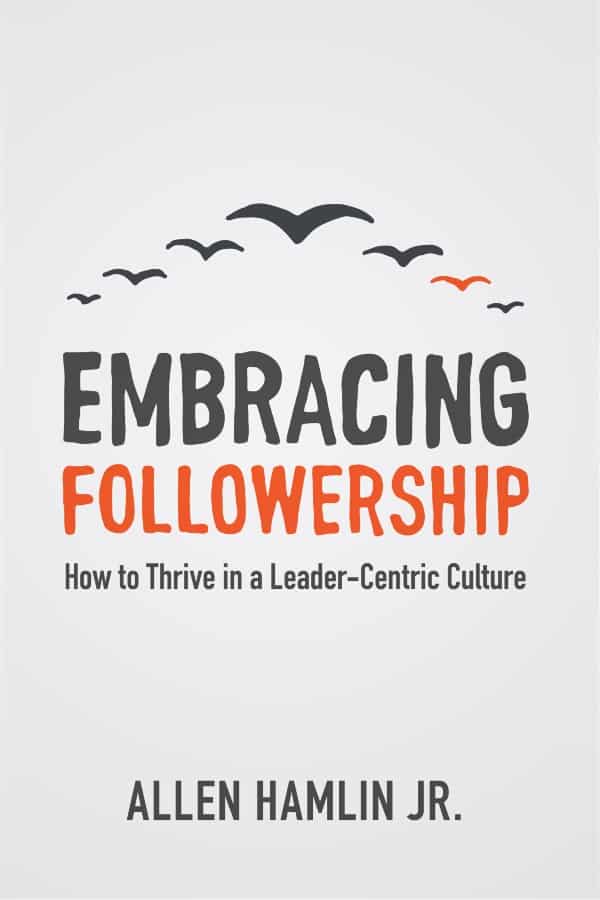⏱️ Estimated Reading Time: 5 min read
Take a look around the bookstore next time you’re in it, and look for the section of books on leadership. Whether it’s management, entrepreneurship, or just general leadership growth in daily life, we have hordes of material on leadership coming at us on a regular basis in the form of seminars, workshops, blogs, the list is endless. Learning about leadership is its own enterprise these days, and oddly enough, we’re still seeing the need for leadership to be taught. Maybe forcing everyone into a leadership mindset isn’t the right answer after all.
Allen Hamlin Jr. has written a book that is long overdue to hit our bookstore shelves. “Embracing Followership” is built on the premise outlined above: that some people — arguably, most people — should be striving to become good followers:
My intent in this book is to equip those in follower roles to understand, value, and execute those roles with excellence. Whether we work in an office, sit in a classroom, serve on a community, play on a team, or join a congregation, we are followers when other people have titles, authority, and responsibility that include us within their sphere of influence. (1–2)
Immediately after reading the introduction to the book, I knew I was in for a treat, and that this book would really help me in where I’m currently working. As I write this, I’m serving at my church as part of their internship program. The point of the internship is to grow in experience and knowledge in ministry, and that requires a lot of following, watching, listening, and learning. While I hope to one day become a lead pastor of a local church, I understand that leadership traits are important to learn. In this process, I’ve been learning it is critical for me to learn how to follow well. Further, knowing how to follow well will help me understand how to helps those under me, should God allow me to step into a position of leadership. I would recommend this book to any group in a similar situation, such as internship teams, sales teams, etc.
There are a few key highlights from this book. The biggest one for me was actually Part 1, a focus on the misconceptions surrounding “followership,” which in turn opened up all the other parts of the book. This section of the book was one of the most helpful because it is in this section the reader begins to realize all the subtle ways we condition ourselves into thinking wrongly about following. Getting these misconceptions back on the right track helps us see that followership is a lifestyle meant to be embraced. Here are some of the misconceptions Hamlin seeks to address and spends time discussing in the book:
Followers only follow to get ahead.
Followers are unqualified to be leaders.
Leaders are superior versions of followers.
Followers don’t really need leaders.
Another helpful section of the book is when Hamlin discusses the obligations and contributions of followership. As followers, there are behaviors and attributes we should feel obligated to bring to the table in work and life. There are also beneficial contributions we should desire to bring to the table. One key concept Hamlin outlines is the importance of decision-taking instead of the leader’s task of decision-making:
As followers, “we have the responsibility to implement the policies. It takes courage to follow leaders when we are not convinced they are right, courage to truly allow leaders to lead. It is our responsibility to give the policy a chance, to make it work through energetic and intelligent adaptation rather than allow it to fail through literal interpretation or lukewarm execution. We have the right to challenge policies in the policy-making process; we do not have the right to sabotage them in the implementation phase.” This is exemplary decision-taking. (61)
This book was written not merely to inform the follower, but to equip him as well. There are some chapters devoted entirely to equipping the follower with tools and suggestions, such as chapter 11 with a focus on personal development. This book intends to be comprehensive in nature, addressing how the follower views himself, the leader he works under, and his fellow followers, and how the leader should view him. It’s a wide-angle look into the world of followership, and it is a truly empowering resource for those who find themselves in positions of being a follower. No matter our positions at work, we all follow in some scenario — whether it’s our faith, our family, or our friends. Nonetheless, Hamlin has helped us break down the negative cloud that’s surrounded being a follower and helped us realized it is a truly wonderful place to be if it is pursued with the right intentions and attitude.
I’m thankful for a book that’s okay with recognizing that not everyone can be or will be a leader. It’s a book that humbling, yet encouraging; restful, yet exhortative. Thanks to Allen Hamlin Jr. for his hard work on this masterful explanation of the beauty of followership, and thanks to Kirkdale Press for the review copy.



